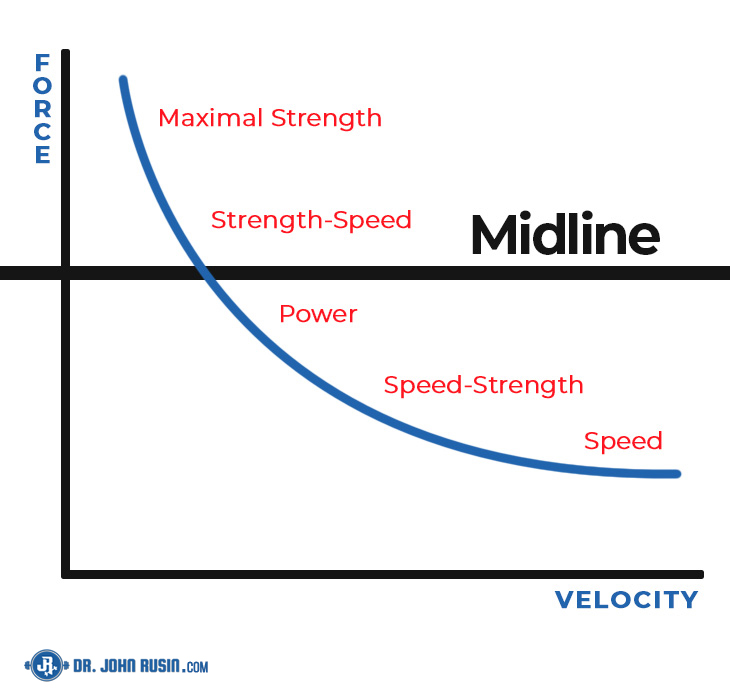The Force-Velocity Curve
Repetitive jumping and landing. Lifting. Change of direction from awkward positions. Extraordinary demands on foot strength. Overhead strength.
These are but some of the physical demands on dancers, which is why as a strength coach I spend so much time thinking about how to expose dancers’ bodies to the appropriate stressors in the gym that will give them reserves of strength and power so that nothing they face onstage or in class will overwhelm their capacity.
To do this well, we have to spend some time thinking about the force-velocity curve, pictured below with an image from Dr. John Rusin’s website in an article from Dr. Jonathan Mike (both of whom are great follows on Instagram if you’re looking to fill your feed with evidence-based practitioners).
The idea here is that a maximal strength movement, like a one-rep max deadlift, would lie near the top left of the curve. And a maximal velocity movement, like throwing a baseball, would be at the bottom right of the curve.
Dancers and athletes need to be able to operate on this curve, with some activities requiring more or less max strength or velocity, and some sports requiring a mix of both. Various forms of dance are striking because of the mix of sometimes low force, low velocity work followed immediately by an extraordinary jump, which would be high velocity.
The relatively high injury rates of dancers owes at least in part to antiquated training methods and an inability to exploit the force-velocity relationship solely using strength methods like Pilates or Gyrotonic, both of which would lie in that athletic dead zone of low force, low velocity. That’s not to say that these modalities don’t have any role at all (we program a lot of low force, low velocity, and isometric work as supplementary exercises), but the point is that this type of work ought to be complementary. If you want to be explosive onstage, then you have to train explosively offstage. It’s a straightforward training concept, but for too many years dancers have relied on class to get them ready for the rigors of stage work and found themselves relatively unprepared as a result.
So what’s the optimal position on the force-velocity curve for a dancer? I think the answer to this question is likely to shift over the next ten years as more dancers are exposed to rigorous strength and conditioning methodology. In our studio, we don’t have any dancers performing lifts that are heavier than 8 rep maxes because almost every dancer we’ve ever encountered hasn’t had a solid foundation in athletic performance-style training. This type of work is different than “working out.”
As the dancers lay a foundation of strength over time, we’ll likely expose them to the more extreme ends of the force-velocity curve, both in terms of maximal strength (think 5 rep max lifts) and maximal velocity. The velocity work we do isn’t all-encompassing of what you would see team sports athletes doing (power cleans, hang cleans, etc.), but we do place a heavy emphasis on plyometric work and medicine ball slams. These are easy to coach, easy to learn ways of getting dancers moving fast, and in the case of plyometrics, absorbing force as well as expressing it. Plyometric work is usually capped at 5 foot strikes per set on 2-leg jumps, hops, and bounds, and 3 foot strikes per side on single leg jumps, hops, and bounds.
When it comes to dancer strength and conditioning, it seems we’re in the position that baseball strength and conditioning coaches were maybe fifteen or so years ago. This athletic performance type of approach just isn’t widely accepted yet, and so we have to prove its efficacy—and safety—as the dance world slowly accepts the change. Once that happens and more dancers are exposed to training (again, as opposed to simply “working out”) then I imagine you’ll see an increasing number of dancers doing more conventional team sports like lifts. I don’t know that we’ll ever get to a point where we’d recommend a female ballet dancer do something like a barbell power clean, but I could see a place for a lift like that among contemporary dancers of all genders and male ballet dancers.
One interesting thing to note about the force-velocity diagram above is that good training prompts the entire curve to shift to the right. In other words, good training means you’ll have access to more strength and more velocity at all points on the curve. That’s the ultimate goal of a strength coach working with a dancer or athlete: give them—and by extension their choreographers and artistic directors—more with which to work and offer expression.
Our Approach
If you’re interested in reading more about our approach, you can be the first to find out about our Dancer’s Guide to Strength & Conditioning, coming this Fall 2019. Go here for more information.

